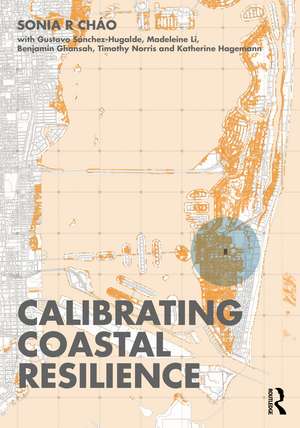Calibrating Coastal Resilience
Autor Sonia R Cháoen Limba Engleză Paperback – 12 feb 2025
Drawing from the authors’ extensive experience in community planning and historic preservation in cities severely affected by the impacts of climate change, this book introduces novel, practical methods for identifying and aligning preservation goals with resilience needs, including flood hazard models, survey instruments, a cultural asset benchmarking system, communication strategies, community toolkits, as well as a discussion of innovative governance structures that support resilience objectives. Refined through real-life application and the experience of Southeast Florida preparing and responding for climate change, these techniques are highly-specialized yet designed for ease of implementation.
A valuable resource for professionals and students of architecture, urban planning, historic preservation, and local government, Calibrating Coastal Resilience offers communities clear guidelines and actionable steps toward creating place-based resilience planning strategies to safeguard the natural and built landscapes of their region.
Preț: 321.01 lei
Preț vechi: 448.54 lei
-28% Nou
Puncte Express: 482
Preț estimativ în valută:
61.43€ • 64.30$ • 51.13£
61.43€ • 64.30$ • 51.13£
Carte nepublicată încă
Doresc să fiu notificat când acest titlu va fi disponibil:
Se trimite...
Preluare comenzi: 021 569.72.76
Specificații
ISBN-13: 9781032404035
ISBN-10: 1032404035
Pagini: 336
Ilustrații: 238
Dimensiuni: 178 x 254 mm
Ediția:1
Editura: CRC Press
Colecția Routledge
Locul publicării:Boca Raton, United States
ISBN-10: 1032404035
Pagini: 336
Ilustrații: 238
Dimensiuni: 178 x 254 mm
Ediția:1
Editura: CRC Press
Colecția Routledge
Locul publicării:Boca Raton, United States
Public țintă
Postgraduate, Professional Practice & Development, Professional Reference, Professional Training, and Undergraduate AdvancedCuprins
Contents
Preface
Author biography
Contributors
Preface
Author biography
Contributors
- Embracing an Ecological Approach to Urban Design in the Anthropocene Era: Invaluable Lessons from History on the Advantages of Understanding, Evaluating, and Coexisting Harmoniously with Nature
Sonia Cháo and Gustavo Sánchez Hugalde - Multi-faceted Challenges and Socio-Economic Considerations
Sonia Cháo with contributions by Gustavo Sánchez Hugalde - Addressing the Nature-Culture Dichotomy through Adaptive City Siting and Design in Response to the Emerging Climate Predicament
Sonia Cháo with contributions by Gustavo Sánchez Hugalde and Madeleine Li - Manifesting the ‘Urban Terroir’: introducing a hyper-local & holistic framework for a climate-challenged era
Sonia Cháo with contributions by Gustavo Sánchez Hugalde - Re-mapping our Future through a Novel Approach: The Urban Terroir Principles, Priorities, Methods, and Tools
Sonia Cháo - Calibrating Coastal Urban Vulnerabilities and Resilience through Modeling
Sonia Cháo and Benjamin Ghansah - The 'SSBV Synoptic Survey': Precedents, Climate-Framework, Associated Protocols, and Contributions to the 'Storm Surge Building Vulnerability Model' Sonia Cháo, Benjamin Ghansah, and Timothy Norris
- Development of the Storm Surge Building Vulnerability Model (SSBV): A Hyper-local Flood Vulnerability Model for Coastal Regions
Sonia Cháo and Benjamin Ghansah - The Storm Surge Building Vulnerability Model: Assessing Coastal Morphological and Typological Paradigms through Four Case Studies
Sonia Cháo and Benjamin Ghansah - Resolving the Terse Paradox Between Historic Preservation and Climate Adaptation: A Proposed Sliding-Scale Benchmarking System
Sonia Cháo - Effectively Communicating Resilient Affordable Housing and Preservation Alternatives Messages to Community Stakeholders
Sonia Cháo and Madeleine Li - The evolving role of governmental partnerships in climate adaptation planning in the face of multiple and escalating flood hazards
Katherine Hagemann, Sonia Cháo and Madeleine Li
Notă biografică
Sonia Cháo teaches, writes, and specialises in sustainable architecture and urbanism, resilient design, and historic preservation in the subtropics. She is the Associate Dean of Research at the University of Miami School of Architecture, the director of the Coastal Resilience (CoRe) Lab. She previously served as one of the founding co-directors of the interdisciplinary Master of Professional Science in Urban Sustainability and Resilience program, and was the prior director of the Center for Community & Urban Design in Miami between 2006 and 2021. She has led various interdisciplinary, and at times inter-institutional, research initiatives, which have led to the development of the SSBV model, the terroir framework, as well as numerous publications, exhibitions, symposia, and partnerships with communities to promote sustainable and climate-resilient design practices. Her work has received support from the National Endowment for the Arts, National Science Foundation, W.K. Kellogg Foundation, the Barr Foundation, and other funders.
Descriere
Calibrating Coastal Resilience presents a conceptual reimagining of place in the era of climate change. Using case studies from South Florida, the book illustrates the unique climate risks for this region with a focus on the preservation of historic neighborhoods and buildings and reinforcement of built structures.
